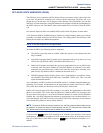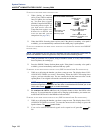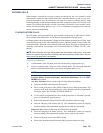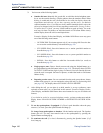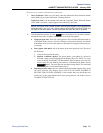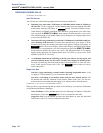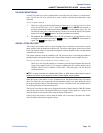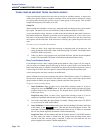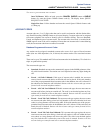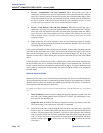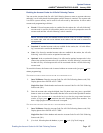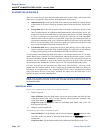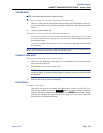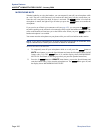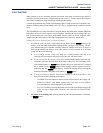
Page 194
System Features
AXXESS
®
ADMINISTRATOR’S GUIDE – January 2004
Trunk Camp On and Busy Trunk Callback (Queue)
TRUNK CAMP ON AND BUSY TRUNK CALLBACK (QUEUE)
Camp-on and queue requests allow the caller to wait for an available resource. A station user
waiting for a specific resource (a trunk or a station) will be served before a station user waiting
for a group that contains that specific resource (trunk group or hunt group). This includes
camped on Emergency Call feature (911) calls.
Camp On
When a station user attempts to select a busy outgoing trunk or trunk group, the system sends a
busy signal. The station user can wait off hook to camp on until the trunk is available.
A user can camp on to busy resources on other nodes and will hear the other node’s music-on-
hold while camped on. When the system has several routing options for a call, it tries to use
each route, in order, until it finds a free route. If it is unable to find a free route, the system tries
once again to use the first route. If the first route is still busy, the system camps on to the first
route.
T
O CAMP ON TO AN OUTGOING TRUNK GROUP:
1. When you hear a busy signal after selecting an outgoing trunk, do not hang up. You
camp on and hear music until a trunk in the trunk group is available. The display shows
WAITING FOR (trunk name).
2. When you hear a single progress tone and outside dial tone, dial the desired telephone
number. The associated Call button or individual trunk button flashes slowly.
Busy Trunk Callback (Queue)
If you attempt to select a busy outgoing trunk group and hear a busy signal or if you camp on,
you can request a callback (queue) and hang up until the system signals your station that a
trunk in the trunk group is available. Each station can place only one queue request at a time. If
a second request is made, the first request is canceled and replaced by the second request.
A user cannot queue onto busy resources on another node.
Queue callbacks must be answered before the Queue Callback timer expires. If a callback is
not answered, the queue is canceled. If the station is busy when a trunk in the queued trunk
group becomes available, the queue request is placed at the end of the queue list.
T
O QUEUE A BUSY OUTGOING TRUNK:
1. Inter-Tel Phones: When you hear a busy signal while selecting a trunk. Or if you are
camped on, press the QUEUE button, or press the Special button and enter the Queue
Callback feature code (6) and hang up. The display shows QUEUE REGISTERED
FOR (trunk name).
Single-Line Sets: When you hear a busy signal while selecting a trunk or if you are
camped on, hookflash and enter the Queue Callback feature code (6). Hang up.
2. Your station rings when the queued trunk is available. Display phones show TG XXXX
(or group name) IS NOW AVAILABLE.
3. Inter-Tel Phones: Lift the handset and/or press the fast-flashing Call button, individual
trunk button, or the button. Then dial the desired telephone number. The
associated Call button or individual trunk button flashes slowly. If ARS was used when
the call was placed originally, the number is dialed automatically.
Single-Line Sets: Lift the handset and dial the desired number. If all DTMF decoders
are busy when your station is called back, the system sends repeating reorder tones
instead of dial tone, and the queue is canceled. If ARS was used when the call was
placed originally, the number is dialed automatically.
ANSWER




